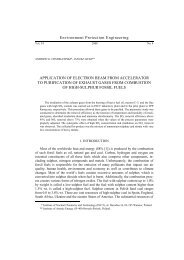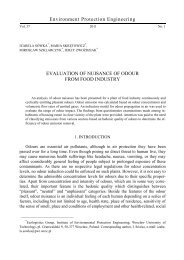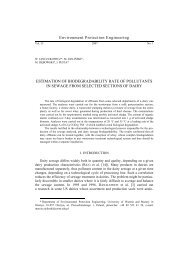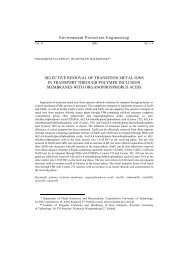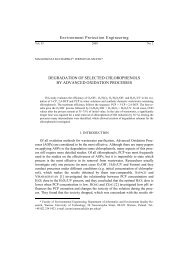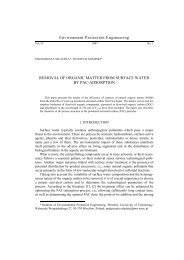Preliminary assessment of use of spider webs for the indication of air ...
Preliminary assessment of use of spider webs for the indication of air ...
Preliminary assessment of use of spider webs for the indication of air ...
Create successful ePaper yourself
Turn your PDF publications into a flip-book with our unique Google optimized e-Paper software.
176<br />
J. RYBAK et al.<br />
opment <strong>of</strong> cancer cells. The most dangerous are benzene, polycyclic aromatic hydrocarbons<br />
(PAH), dust and heavy metals. Dust is a serious threat. Coal particles have<br />
very high absorption capacity and <strong>the</strong>re<strong>for</strong>e diverse toxic substances settle easily on<br />
<strong>the</strong>ir surface, including carcinogenic hydrocarbons and heavy metals [7]. Dust participates<br />
in transporting <strong>the</strong>m inside <strong>the</strong> human body. It irritates eyes, skin and respiratory<br />
tract (pneumoconiosis). Diesel engines are main source <strong>of</strong> dust emission [8].<br />
As <strong>spider</strong> <strong>webs</strong> absorb <strong>air</strong> pollution from <strong>the</strong> environment, <strong>the</strong>y can be <strong>use</strong>ful indicators<br />
<strong>of</strong> <strong>air</strong> quality. The advantages <strong>of</strong> application <strong>of</strong> <strong>spider</strong> <strong>webs</strong> are as follows: low<br />
cost <strong>of</strong> samples collection, availability <strong>of</strong> <strong>the</strong> research material, secluded location preventing<br />
<strong>the</strong>ir destruction by wea<strong>the</strong>r conditions (falls, wind, snow) and people, noninvasiveness<br />
<strong>of</strong> studies (no need <strong>of</strong> killing animals), easy collection <strong>of</strong> samples. Moreover,<br />
studies conducted so far [9] show that cumulative ability <strong>of</strong> <strong>webs</strong> is an additional<br />
advantage. Such ability, being a consequence <strong>of</strong> its chemical structure, gives an unique<br />
opportunity to asses an <strong>air</strong> pollution level in a long-term period, contrary to <strong>the</strong> classic<br />
measurements which could only deliver in<strong>for</strong>mation about <strong>the</strong> temporary state <strong>of</strong> <strong>the</strong><br />
environment. Additionally, measurement <strong>of</strong> concentrations <strong>of</strong> pollutants is usually carried<br />
out with expensive and inconvenient equipment (large-sized and noisy apparatus).<br />
On <strong>the</strong> opposite, <strong>webs</strong> collection from tunnel walls is fast and enables one to study<br />
a long-term influence <strong>of</strong> pollutants only by single examinations (e.g. 7 or 30 days).<br />
Application <strong>of</strong> high-tech passive dosimeters <strong>for</strong>mally discredits <strong>the</strong> legitimacy <strong>of</strong><br />
<strong>webs</strong> <strong>use</strong>, however it is worth to emphasize that even a relatively cheap and simple<br />
dosimeters cannot be left in random places in case <strong>of</strong> <strong>the</strong>ft or destroy. Ano<strong>the</strong>r advantage<br />
is that <strong>webs</strong> are usually found in large numbers, <strong>of</strong>ten in places where it is hard to<br />
install <strong>the</strong> dosimeter and usually do not attract any attention. What is more, it is possible<br />
to date <strong>the</strong> time <strong>of</strong> <strong>the</strong> web exhibition to pollutants by removing <strong>the</strong> old web and<br />
using only a new construction.<br />
Cumulative ability <strong>of</strong> <strong>spider</strong> <strong>webs</strong> has not been analysed in Poland. Assessment <strong>of</strong><br />
<strong>use</strong>fulness <strong>of</strong> <strong>webs</strong> <strong>for</strong> <strong>the</strong> <strong>indication</strong> <strong>of</strong> <strong>the</strong> environment is <strong>the</strong> aim <strong>of</strong> presented studies.<br />
The obtained results could contribute to <strong>the</strong> development <strong>of</strong> an easy method <strong>of</strong><br />
pollution <strong>indication</strong> which can function almost all year round (<strong>webs</strong> can be obtained<br />
under laboratory conditions by breeding <strong>spider</strong>s) which could be an additional advantage<br />
<strong>of</strong> <strong>the</strong> method, unlike <strong>the</strong> majority <strong>of</strong> bio<strong>indication</strong> methods where application is<br />
<strong>of</strong>ten limited only to <strong>the</strong> vegetative season (e.g. <strong>assessment</strong> <strong>of</strong> water quality based on<br />
benthic macroinvertebrates) [10, 11].<br />
2. EXPERIMENTAL<br />
Webs were collected from <strong>the</strong> two following study sites within city <strong>of</strong> Wrocław.<br />
Site 1. Hydrotechnical building on water supplying areas <strong>of</strong> Wrocław (wet ponds)<br />
is located in <strong>the</strong> south-east part <strong>of</strong> <strong>the</strong> city. A flat area (1026 hectares) consisted <strong>of</strong>



